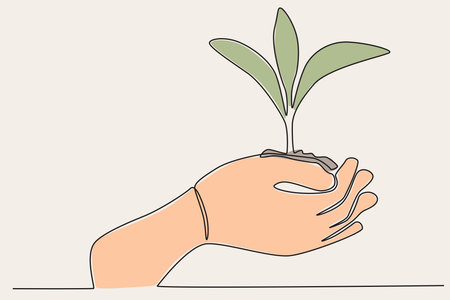Understanding the Money Plant in Indian Culture
The money plant, known locally as “Epipremnum aureum” or “Pothos,” holds a cherished place in Indian households. For generations, this lush green climber has been celebrated not only for its aesthetic appeal but also for its deep-rooted significance in Indian tradition and Vastu Shastra. The belief that the money plant brings prosperity and wealth is widespread across India, and it is often gifted during housewarmings or festivals as a symbol of good fortune.
Within the framework of Vastu, which guides the harmonious arrangement of spaces, the money plant is considered an auspicious addition to homes and offices. According to age-old customs, placing a healthy money plant indoors is thought to invite positive energies, enhance financial stability, and ward off negative vibes. It is not uncommon to see this evergreen vine adorning living rooms, balconies, and even workspaces, signifying both abundance and growth.
Moreover, the money plant’s resilience and easy maintenance make it a popular choice among urban dwellers who seek a touch of nature and prosperity amidst modern lifestyles. Its reputation as a harbinger of luck and wealth continues to thrive across Indian cities and villages alike, strengthening its place as a must-have plant in every home aspiring for happiness, harmony, and success.
2. Vastu Shastra Guidance for Placing Money Plant
According to the ancient Indian science of architecture, Vastu Shastra, the placement of a money plant inside your home is crucial for attracting prosperity and positive vibes. The direction and location where you keep your money plant can influence the flow of wealth and harmony in your household. Vastu experts in India recommend specific areas to place your money plant so that it not only beautifies your living space but also ensures abundance and good fortune for your family.
Recommended Directions for Money Plant Placement
| Direction | Vastu Benefits |
|---|---|
| South-East (Agneya) | Best for financial growth and prosperity; ruled by Lord Ganesha and Venus. |
| East | Promotes health, positivity, and new opportunities. |
| North | Enhances career success and stability. |
Where Not to Place Your Money Plant
- Avoid keeping the money plant in the North-East corner as it may lead to financial difficulties.
- Do not place the plant outside your house or in the garden; it should always be indoors for best results.
Practical Tips for Placement
- The money plant should be kept in a green bottle or pot for added Vastu benefits.
- Ensure the plant is healthy and its leaves are lush; dried or withered leaves should be removed immediately.
By following these simple yet effective Vastu guidelines, you can harness the full power of the money plant to invite Lakshmi Mata’s blessings, wealth, and serenity into your Indian home.

3. Selecting and Caring for Your Money Plant
Tips for Choosing Healthy Money Plants
When bringing a money plant (Epipremnum aureum) into your home, begin by choosing healthy specimens from a trusted nursery or local market. Look for vibrant green leaves without any yellowing or brown spots. The stems should be firm, not wilted, and the roots should appear white and strong. For best Vastu results, select a plant that looks lively and robust, as this is believed to bring more positive energy and prosperity to your home.
Simple Care Routines for Indian Homes
Caring for a money plant in India is easy and rewarding. Place your money plant in indirect sunlight—direct sun can scorch the leaves, especially during hot Indian summers. A well-lit corner near a window or balcony is ideal. Water your money plant when the top inch of soil feels dry; overwatering can lead to root rot, so always check the soil before watering again. In most Indian climates, watering once or twice a week is sufficient, but adjust based on the season and humidity.
Nurturing Money Plant with Natural Soil Mixes
For sustainable growth, use a natural potting mix made from garden soil, composted cow dung, and a bit of river sand for good drainage. This mixture provides essential nutrients while keeping the roots healthy in Indian weather conditions. Repot your money plant every year or when it outgrows its container to ensure steady growth and abundant foliage.
Sunlight & Watering Requirements in Indian Climates
In tropical and subtropical regions of India, protect your money plant from harsh afternoon sun by placing it in partial shade. During monsoons, reduce watering frequency as the air remains humid. In drier months, mist the leaves occasionally to maintain moisture and prevent dryness. Remember, caring for your money plant with patience and love reflects the core principles of natural farming—let nature guide you in nurturing prosperity within your home.
4. Sustainable Practices for Growing Money Plant
For Indian homes that value prosperity, beauty, and harmony with nature, adopting sustainable methods to grow your money plant is both practical and rewarding. Following age-old traditions and eco-friendly practices not only ensures a healthy plant but also aligns with vastu principles for positive energy. Here are some time-tested, chemical-free ways to nurture your money plant:
Utilise Kitchen Waste for Natural Nutrition
Instead of using synthetic fertilisers, enrich the soil with everyday kitchen waste like vegetable peels, used tea leaves, and fruit scraps. These organic materials decompose easily and provide essential nutrients to your money plant, promoting lush growth without harming the environment.
Clay Pots: The Desi Choice
Choose earthen or clay pots over plastic ones. Clay pots are porous, allowing excess water to evaporate and roots to breathe freely. This traditional Indian method helps maintain ideal moisture levels, prevents root rot, and keeps the plant cool even during hot summers.
Desi Compost for Chemical-Free Gardening
Homemade desi compost is a natural way to boost soil fertility. Start a small compost pit in your backyard or use a clay pot on your balcony to recycle food waste into nutrient-rich compost. Regularly adding this compost to your money plant will result in robust growth and vibrant leaves.
Comparison Table: Eco-Friendly vs Conventional Methods
| Aspect | Eco-Friendly Method | Conventional Method |
|---|---|---|
| Nutrition Source | Kitchen waste & desi compost | Chemical fertilisers |
| Pots Used | Clay/earthen pots | Plastic pots |
| Environmental Impact | Sustainable & biodegradable | Non-biodegradable & polluting |
| Health of Plant | Lush, long-lasting growth | Quick growth but risk of toxicity |
Tips for a Greener Home Garden:
- Water your money plant with leftover rice water or diluted buttermilk for extra nutrients.
- Avoid overwatering; check the soil moisture before watering again.
- Place the pot in indirect sunlight as per vastu recommendations to attract positive energy.
- Regularly prune dried or yellow leaves to maintain plant health and aesthetics.
Cultivating money plants using these eco-friendly, traditional Indian methods supports sustainable living and enhances the vastu benefits in your home. By reconnecting with our roots and respecting Mother Earth, we invite both prosperity and peace into our living spaces.
5. Tips to Enhance Prosperity and Home Décor
Creative Indian Ways to Style Your Money Plant
Bringing prosperity into your home with a money plant is not just about placement—how you style the plant also matters, both for Vastu and aesthetic appeal. In India, creative and sustainable practices are deeply rooted in tradition and everyday life. Here are some inspiring ways to showcase your money plant while honouring these values:
Use of Recycled Bottles
Transform used glass or plastic bottles into eco-friendly planters for your money plant. Simply cut the bottle, decorate it with vibrant Indian motifs using natural dyes or paints, and hang it near windows or balconies. This not only supports sustainability but also symbolises the flow of positive energy as per Vastu principles.
Terracotta Pots: Earthy Connection
Terracotta pots have long been an integral part of Indian households. Their earthy texture and porous nature help maintain soil health and regulate moisture for your money plant. Arrange a cluster of terracotta pots in your living room corners or entrance area to create a welcoming and auspicious vibe that resonates with the five elements of Vastu Shastra.
Traditional Jute Hangers
Embrace traditional craftsmanship by suspending your money plant in handwoven jute hangers. These natural fibre holders are not only eco-conscious but also add rustic charm to modern apartments and homes alike. Hang them at eye level or above doorways to attract wealth and harmony as recommended by Vastu experts.
Personal Touches for Prosperity
Add rangoli designs around your money plant pot during festivals, tie sacred red threads (kalava) on the container, or place diyas nearby for special occasions. These small yet meaningful touches amplify the spiritual aura, inviting Lakshmi—the goddess of wealth—into your home.
By integrating these creative Indian styling ideas, you can enhance both the prosperity and visual appeal of your home while staying true to Vastu traditions and sustainable living.
6. Common Beliefs and Myths Around Money Plant
The money plant, or “Epipremnum aureum,” holds a cherished place in Indian homes not just for its lush green beauty but also for the deep-rooted beliefs and superstitions surrounding it. Across India, this plant is considered a symbol of prosperity, good luck, and wealth, often closely associated with the blessings of Goddess Lakshmi.
Money Plant as a Harbinger of Wealth
It is widely believed that keeping a healthy money plant in your house will attract financial gains and keep poverty at bay. Many families place the plant near entrances or in the southeast corner of their homes, as prescribed by Vastu Shastra, to maximize positive energy flow and welcome abundance.
Superstitions: What to Avoid
There are several common superstitions regarding the care of the money plant. For example, people say you should never let your money plant dry out or wilt; a dying money plant is thought to bring financial troubles. Another widespread belief is that you must not allow others to take cuttings from your plant, as this may transfer your luck and prosperity to them.
Traditional Rituals and Practices
Some households perform simple rituals when planting or watering the money plant, such as chanting prayers to Lakshmi Mata or lighting a diya nearby. Fridays are considered auspicious for tending to the money plant, with devotees offering fresh water while seeking blessings for wealth and harmony.
Popular Stories Passed Down Generations
Indian folklore abounds with tales of families whose fortunes changed after nurturing a thriving money plant. From stories of sudden business growth to unexpected gains, these narratives fuel the faith in the plant’s power to transform lives when cared for respectfully and kept in accordance with Vastu principles.
In summary, whether you embrace every myth or simply enjoy its green charm, the money plant continues to grow as an evergreen symbol of hope and prosperity in Indian culture, inspiring mindful care and gratitude for nature’s abundance.

